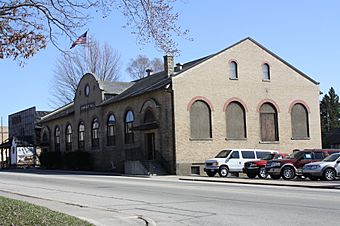Hortonville Community Hall facts for kids
Quick facts for kids |
|
|
Hortonville Community Hall
|
|

Hortonville Community Hall
|
|
| Location | 312 W. Main St., Hortonville, Wisconsin |
|---|---|
| Area | 0.1 acres (0.040 ha) |
| Built | 1912 |
| Architect | Robert Messmer |
| Architectural style | Spanish Colonial Revival |
| NRHP reference No. | 81000053 |
| Added to NRHP | January 23, 1981 |
The Hortonville Community Hall is a special building located in Hortonville, Wisconsin. It has been an important part of the town's history for over a hundred years. This historic hall has served many purposes for the community.
Contents
About the Hortonville Community Hall
The Hortonville Community Hall was built in 1912. It was designed by an architect named Robert Messmer. The building has a unique look, following a style called Spanish Colonial Revival architecture. This style makes the hall stand out in the town.
A Look at Its Past
When the Hortonville Community Hall first opened, it was a busy place. It served as a central spot for many different activities. People used it as a meeting hall, where important town decisions were made. It was also a popular dance hall, where folks could gather for fun and music.
The hall even worked as an opera house. This means people could watch plays and musical performances there. Imagine the excitement of seeing a show in this very building! It was a true center for entertainment and community life.
What is Spanish Colonial Revival Style?
The Hortonville Community Hall shows off the Spanish Colonial Revival style. This type of architecture became popular in the early 1900s. It often includes features inspired by old Spanish buildings. You might see things like red tile roofs, arched doorways, and decorative ironwork. The style often uses stucco or brick, giving buildings a warm, inviting feel. It brings a bit of sunny Spanish charm to places like Wisconsin.
Why is it a Historic Place?
Because of its long history and unique architecture, the Hortonville Community Hall is very important. It was officially listed on the National Register of Historic Places in 1981. This is a special list kept by the United States government. It recognizes buildings, sites, and objects that are important to American history.
Being on this list helps protect the building. It means the hall is recognized for its historical value. Later, in 1989, it was also added to the State Register of Historic Places. This shows its importance to the history of Wisconsin itself. These listings help make sure the hall can be enjoyed for many more years.

